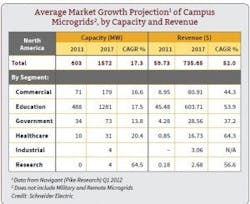The microgrid market is clearly on the rise. What is the potential? How quickly will it develop? And what economic factors will drive or hamper it?
North America, especially the United States, is the center of a microgrid market that Navigant Research expects to reach $40 billion annually by 2020, up from $10 billion in 2013. Capacity will grow from 866 MW in 2014 to 4.1 GW in 2020 under a base case scenario described in Navigant’s report, “Microgrids.”
The research firm characterizes the industry as moving into its next phase of project development – commercialization. Two types of microgrids will attract the most attention: Grid-tied and direct-current, according to Navigant.
Exactly what the industry will look like, and how much it will grow over the next several years, depends upon decisions being made now by government and industry. “The key to future growth in microgrid now rests with greater creativity in both the public policy and business model arenas,” Navigant says.This is the third article from our special report, Think Microgrid.
Frost & Sullivan also sees the US as the clear leader in microgrids, largely because of its military, which has created a springboard for private sector development. Its analysis predicts rapid microgrid growth from 2015 to 2020. The research firm says it is likely that utilities will be among the players that will deploy microgrids. (We see other likely microgrid developers to be municipal governments, public power and municipal utilities, institutions and healthcare, energy management and operation companies, independent power producers, independent transmission companies, solar and energy storage developers, and technology and engineering firms.)
Suba Arunkumar, Frost & Sullivan energy and environment industry manager, describes expansion potential as “immense” for players across the microgrid value chain. “First-mover advantage will be prominent for participants venturing into the market within the short term,” Arunkumar said.
“First-mover advantage will be prominent for participants venturing into the market within the short term,” Arunkumar said.
Frost & Sullivan warns that microgrid development can be expensive, especially for those facilities that integrate into a central grid. Costs are high, in part, because of a proliferation of custom interfaces and a lack of their standardization. To overcome this problem, Europe is building microgrid networks for field tests and analysis, says Frost & Sullivan.
Similar problems about technology are raised in a Sandia National Laboratories report, “The Advanced Microgrid Integration and Interoperability,” by Ward Bower, Dan Ton, Ross Guttromson, Steve Glover, Jason Stamp, Dhruv Bhatnagar and Jim Reilly.
“…much basic technology does exist today, but some products are often not well matched and much of existing technology deserves improvements in reliability, two-way communications, and standardization…Today’s developments toward an advanced microgrid are already moving forward but sometimes in a disparate manner.”
Many college and universities have valuable experience operating and optimizing microgrids, developed through many years of integration and focus on delivering highly reliable energy services to mission critical end-users, such as laboratories; research centers, surgeries and data centers. US institutions often host invaluable research projects that demand constant, precise temperature and humidity settings, and accordingly have not relied solely on the commercial electricity grid. These microgrids are essential infrastructure and are designed to deliver highly resilient energy services.
How large the market grows for advanced microgrids remains to be seen and depends on regulatory and policy movement, as well as continued success honing the technology and reducing interface costs. Even with these advances, some see microgrids as always being niche. Others describe a future grid comprised of mostly microgrids with the central grid acting as the coordinator.
Come back next week for the fourth article in this series, or immediately download the full report, free of charge: Think Microgrid: A Discussion Guide for Policymakers, Regulators and End Users, courtesy of the report’s underwriters: the International District Energy Association, Schneider Electric and Microgrid Knowledge







